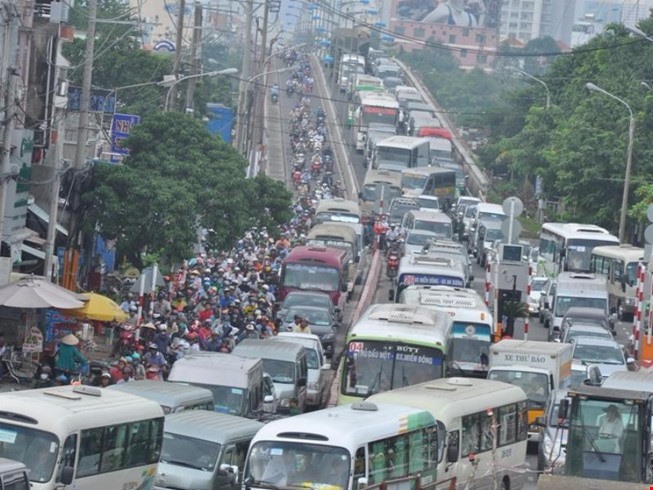 Society
Society

Prime Minister Nguyễn Xuân Phúc on Monday called on authorities in HCM City to continue efforts to tackle the worsening traffic congestion in the city.
 |
| Traffic congestion on a HCM City street. The city plans to take immediate measures to curb traffic jams. Photo plo.vn |
HCM CITY — Prime Minister Nguyễn Xuân Phúc on Monday called on authorities in HCM City to continue efforts to tackle the worsening traffic congestion in the city.
Phúc, along with Deputy PM Trịnh Đình Dũng, organised an online conference with city leaders and State agencies to seek urgent measures to address the issue.
PM Phúc, who chaired the online conference in Hà Nội, asked the city to reorganise the city’s traffic activities in a more appropriate manner.
Phúc urged the city to restrict the number of personal vehicles as well as promote public transport in the country’s largest city.
He said that a number of facilities should be relocated away from the downtown area, while priority should be given to construction of public places such as parks and pedestrian areas instead of high-rises.
Phúc said he appreciated the city’s efforts and coordination with agencies to tackle the problem, but called on the city to establish a clear and strong roadmap to improve congestion.
He also said the city should stop building high-rises in the city centre where traffic infrastructure remains insufficient.
The PM also urged the city government to continue to work out immediate solutions to address traffic congestion, particularly ahead of Tết (Lunar New Year) holiday, which begins this week.
Drivers of vehicles in HCM City have increasingly lodged complaints about serious traffic jams in recent days.
Also speaking at the online conference, Party Secretary Đinh La Thăng said HCM City authorities would make a concerted effort to improve the situation, especially before and during the holiday.
The days ahead of Tết see a hike in traffic volume due to higher demand for goods deliveries, while residents are busy shopping for the most important holiday of the year or paying visits to friends and business partners.
Lê Văn Khoa, vice chairman of the city’s People’s Committee, said the city had managed to resolve traffic congestion at seven out of 37 traffic congestion hotspots last year.
Poor traffic infrastructure, however, had not kept up with the rapid rise in the number of personal vehicles, especially motorbikes and automobiles, Khoa said.
Population growth due to the increasingly high number of migrants from other provinces, mostly from the central and northern regions, has also contributed to worsening traffic conditions.
Congestion will become even worse in the next few years if no effective measures are taken or no appropriate policies are applied on the use of personal vehicles, particularly automobiles, he added.
Urban planning
Khoa said the city would focus on a number of measures to curb traffic jams, including using traffic infrastructure effectively.
The city will continue to improve public transport and restrict the number of personal vehicles as well as enhance people’s education and awareness of traffic laws.
Law enforcement on traffic safety and order must also be enhanced, he said.
The city is continuing to review and manage urban planning to ensure smooth traffic in the downtown area and on roads to surrounding provinces.
As part of its urban planning to 2025, the city is applying IT to improve the traffic situation.
The city’s Transport Department, for example, has launched a digital traffic app that provides recommendations for the most appropriate routes for commuters to reach their destination, and helps them avoid certain streets with serious gridlock or where accidents occur.
The app updates its users on traffic situations at specific times, including the volume of traffic, speed of vehicles, and traffic flow images at congested hotspots across the city (using more than 300 cameras operated by the department).
The city has 37 congestion hotspots, including the Tân Sơn Nhất airport area (Trường Sơn, Trần Quốc Hoàn, Hoàng Văn Thụ, Cộng Hoà, Trường Chinh, Nguyễn Văn Trỗi and Nguyễn Kiệm streets), Cát Lái Port, downtown area, and streets that connect the city with outlying districts.
Khoa said traffic congestion at the airport area and Cát Lái Port in particular had become more serious.
The city also plans to develop a series of road infrastructure projects to address the issue at these locations and other congestion hotspots, Khoa told conference attendees.
Total investment for the project would be nearly VNĐ324 trillion (US$14.36 billion) in the 2016-20 period, according to Khoa.
At the conference, delegates also discussed measures to combat worsening congestion around Tân Sơn Nhất International Airport.
The airport is seriously overloaded, both on the ground and in the air. It serves 28 million passengers per year even though its capacity was originally planned to be only 25 million per year until 2020, speakers said.
Phúc said that the Government was determined to work closely with the city to seek “long-term and consistent measures to curb traffic congestion, including mobilising all resources”.
Traffic congestion has become one of the most serious problems in the country’s largest cities, HCM City and Hà Nội.
With a population of more than 10 million, HCM City is seeking urgent measures to tackle traffic jams, especially during rush hour.
The city is considering changing some major streets to one-way streets, building elevated roads, and even banning private vehicles from downtown areas.
Nearly 9 million motorbikes are in use on more than 4,000 kilometres of roads in the city, not to mention private cars and bicycles.
Nearly 4,200 new cars and 9,000 new motorbikes are registered every month, while public transport is limited to buses. — VNS




